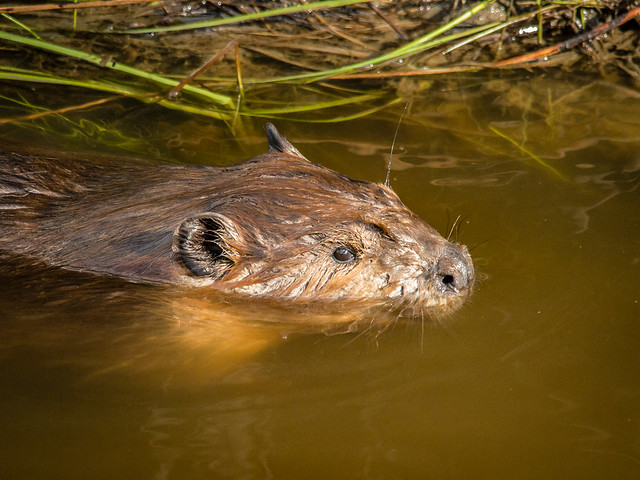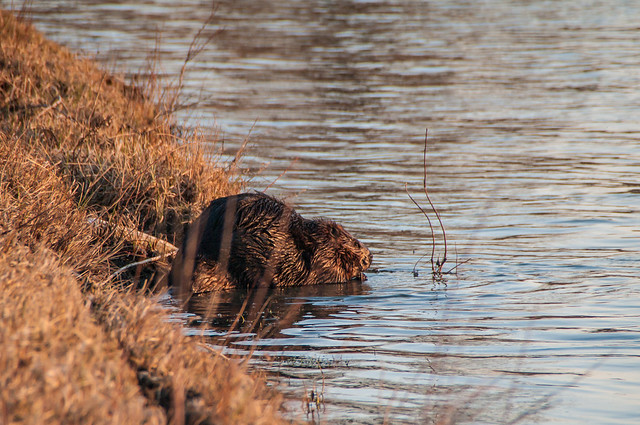“The fact that beavers still exist in North America, and in Europe for that matter, is nothing short of a miracle. Their tenacious nature and ability to survive major geologic and climatic shifts is amazing in its own right, but their ability to survive a level of overexploitation that would have crippled many other species is a testament to their ecological adaptability.” (The Beaver Manifesto)
Glynnis Hood says, “We want to co-exist with wildlife, but we want it to be well-behaved wildlife, much like our lawn ornaments.” Her book, The Beaver Manifesto, provides a fascinating glimpse of the complex relationship between humans and beavers over the centuries.
Adaptation and Survival
Ancestors of the modern beaver first appeared on the scene between 54 and 38 million years ago. “By the time early hominid ancestors appeared, just short of 5 million years ago, early beavers had already learned to cut wood and build homes.”*
Early North American beavers varied in size from small ones weighing less than 1.5 kilograms to a giant beaver that was 3 metres long and the size of a female black bear.
Beavers’ adaptability has helped them to succeed against all odds and in North America they can be found from the Gulf of Mexico to the Arctic Ocean. They control their environment by building dams and creating deep ponds that don’t freeze in winter.
As semi-aquatic animals, they can use the water to transport their food. An underwater pantry means the food is accessible throughout the year. Their lodges, surrounded by a watery moat, provide a safe place to raise their young.
Felt Hats and Beaver Pelts
The beavers’ greatest adversary has been and remains human beings. When Europeans first arrived in North America, there were an estimated 60-400 million beavers across the continent. The explorers were delighted to spot this economic opportunity as they had already almost wiped out the European beaver population in their quest for fur, food, and medicine. Tall felt hats had recently become popular and there was a ready market for beaver pelts.
Hunters and trappers followed the beavers up the Canadian waterways, moving further inland as beavers became scarce and opening up the country to immigration and settlement. It was the start of Canada’s economic reliance on natural resources.
The Hudson Bay Company’s records show that over 4.7 million beaver pelts reached British auction houses between 1769 and 1868. And these figures don’t include the pelts that were judged sub-standard and discarded.
The beavers survived 300 years of commercial exploitation, but only just. By 1870, very few remained. Their numbers continued to decline as wetlands were drained, towns established, and farmland extended. But beavers are resilient, and they’ve made an impressive comeback.
Environmental Engineers
The return of the beaver brings benefits for nature and humans. As beavers move into new territory, they dam a stream creating a pond for their lodge. Willows, aspens and other trees begin to grow around the edge of the pond. The slow-moving water is an ideal habitat for fish, while birds and wildlife benefit from the new growth of grass and shrubs.
Beavers also restore land that has been damaged. Glynnis Hood tells the story of Eric Collier and his family who moved to an area near Williams Lake in the 1930s. “When they first moved to the area, streams were dry, wildlife was depleted and forest fires were a constant threat.” Honouring his grandmother’s request to bring beavers back to the land, Collier started rebuilding the beaver dams and a conservation officer dropped off two pairs of beavers. By 1950, “the entire valley was vibrant with wildlife and wetlands.”
Beavers mitigate the effects of extended drought. Hood observed beavers on the Prairies and found that the animals dug channels in the bottoms of ponds to direct what water there was to where it was needed. “By the time the drought of 2002 was in full swing, the ponds that still contained water were most often those occupied by beavers.”
Beaver ponds help regulate storm water drainage, mitigating the risk of flash floods. Their engineering efforts help replenish the water table and restore streams to a more natural state.
Conflict Management
Municipal officials and riverside residents are quick to blame beavers for damaging trees, flooding roads, and creating ponds where people don’t want them. However, removing a beaver dam or trapping and killing the beavers is an ineffective, short-term solution. Beavers will quickly rebuild the dam and other beavers will repopulate the area.
Banding trees with metal and installing beaver bafflers on culverts to maintain a water level in the pond that is adequate for the beavers without causing flooding and problems for other species is far more effective.**
Glynnis Hood provides a balanced perspective: “It is frustrating to have expensive facilities, trees and equipment damaged, but it is also important to appreciate all the ecological benefits that are part of a beaver’s world. In many situations, it is also time to stop seeing the beaver as a pest and more as a pilot to navigate us through a warming climate and the complex ecological challenges it brings. . . .
“We are still consumers of natural resources, and by our nature as human beings we always will be, in order to survive. But how we manage those resources is critical. Loving nature to death while denying its needs is not a viable approach. To manage the conflicts between wildlife and humans requires an experiential understanding of our wild neighbours and the creativity, time and adaptability to do the right thing while we still have a chance.”
 * Unless specified otherwise, quotes are from The Beaver Manifesto
* Unless specified otherwise, quotes are from The Beaver Manifesto**“In many areas, specialized flow-control devices have been installed to allow water to be drained from beaver ponds quietly so that beavers don’t hear the sound of running water that drives them to action. They remain none the wiser and are not inspired to plug the culvert and raise the level of their pond to new heights. The ponds stay at stable and ecologically valuable levels, happy beavers remain on the landscape and infrastructure such as roads and trails remains intact.”
Additional Information
Glynnis Hood, The Beaver Manifesto, Rocky Mountain Books, 2011, is available from the Saskatoon Public Library and McNally Robinson Booksellers
“beavers are getting new respect these days. Across the West, they are being welcomed into the landscape as a defense against the withering effects of a warmer and drier climate.” (New York Times, 2014)
“Using their skills as natural builders and brilliant hydro-engineers, beavers are being recruited to accomplish everything from finding water in a bone-dry desert to recharging water tables and coaxing life back into damaged lands.”(PBS videos and infographics)
Urban beavers are part of a storm water management policy in this Oregon neighbourhood (7:40 minute video)
Grey Owl’s cabin in Prince Albert National Park is accessible on foot or by boat. There is also a film about Grey Owl.


